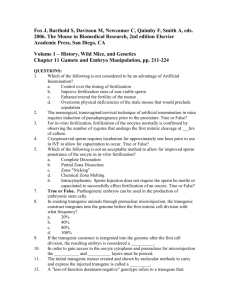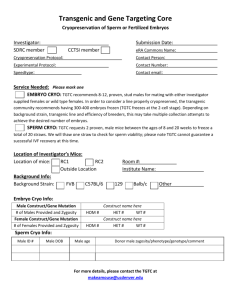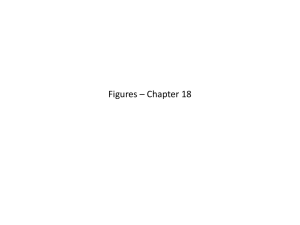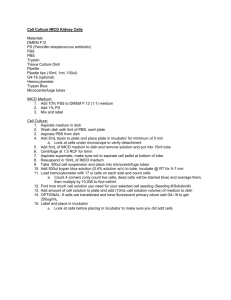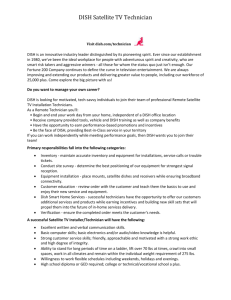1. Cryopreservation of Mouse Spermatozoa in 1.8ml cryotubes
advertisement
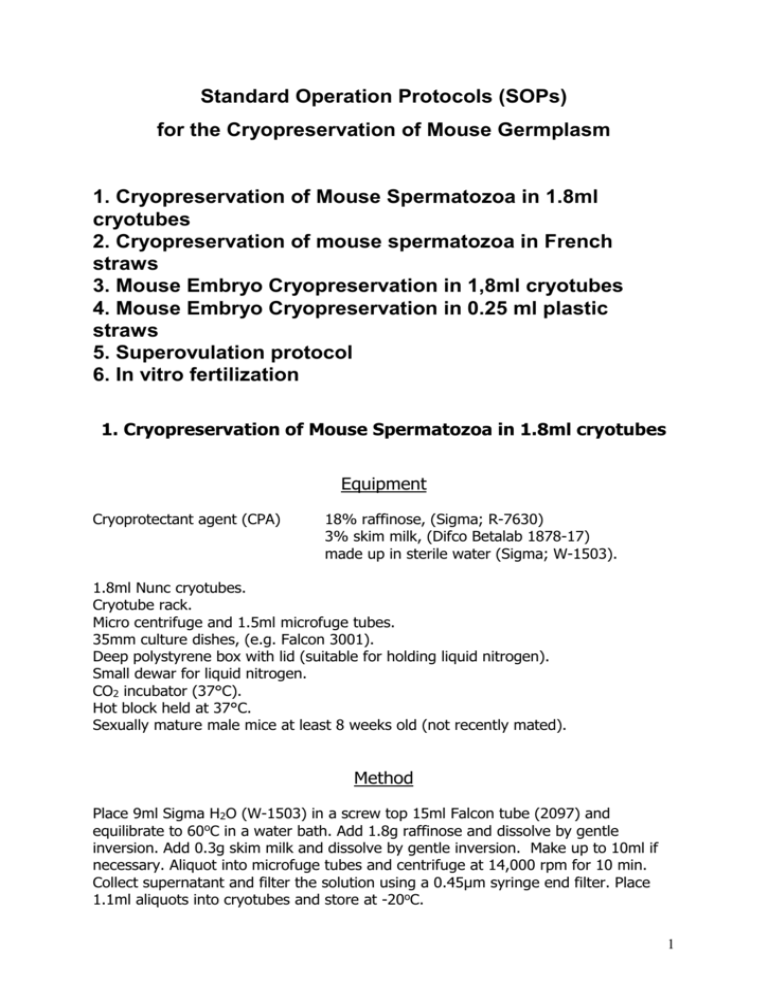
Standard Operation Protocols (SOPs) for the Cryopreservation of Mouse Germplasm 1. Cryopreservation of Mouse Spermatozoa in 1.8ml cryotubes 2. Cryopreservation of mouse spermatozoa in French straws 3. Mouse Embryo Cryopreservation in 1,8ml cryotubes 4. Mouse Embryo Cryopreservation in 0.25 ml plastic straws 5. Superovulation protocol 6. In vitro fertilization 1. Cryopreservation of Mouse Spermatozoa in 1.8ml cryotubes Equipment Cryoprotectant agent (CPA) 18% raffinose, (Sigma; R-7630) 3% skim milk, (Difco Betalab 1878-17) made up in sterile water (Sigma; W-1503). 1.8ml Nunc cryotubes. Cryotube rack. Micro centrifuge and 1.5ml microfuge tubes. 35mm culture dishes, (e.g. Falcon 3001). Deep polystyrene box with lid (suitable for holding liquid nitrogen). Small dewar for liquid nitrogen. CO2 incubator (37°C). Hot block held at 37°C. Sexually mature male mice at least 8 weeks old (not recently mated). Method Place 9ml Sigma H2O (W-1503) in a screw top 15ml Falcon tube (2097) and equilibrate to 60oC in a water bath. Add 1.8g raffinose and dissolve by gentle inversion. Add 0.3g skim milk and dissolve by gentle inversion. Make up to 10ml if necessary. Aliquot into microfuge tubes and centrifuge at 14,000 rpm for 10 min. Collect supernatant and filter the solution using a 0.45µm syringe end filter. Place 1.1ml aliquots into cryotubes and store at -20oC. 1 Cryopreservation method To prepare the cooling apparatus place a platform (e.g. the insert from a Gilson yellow tip box) into the polystyrene box. This acts as a support for the cryotube rack. Carefully pour liquid nitrogen into the polystyrene box to just cover the platform. Place a cryotube rack on top of the platform so that it is suspended in liquid nitrogen vapour. Replace the lid on the polystyrene box and allow it to fill with vapour. Replenish the liquid nitrogen as necessary during the freezing session, but do not allow the level to rise above the platform. Thaw one 1.1ml aliquot of cryoprotectant solution for each male mouse and bring to 37°C in the incubator or hot block. Mix by inversion if there is any precipitation. Pipette 1.0ml CPA into a small culture dish and place on the hot block at 37oC. Dissect the vasa deferentia and cauda epididymides from the mouse and clean off all fat and blood. This is easily achieved by placing the organs on a paper tissue and examining them under a microscope. Transfer the cleaned organs to the dish of CPA and using watchmaker’s forceps mince the epididymis and squeeze sperm gently out of the vas deferens. To disperse the sperm, gently shake the culture dish for ~30 seconds. Place the dishes lid on a shelf in the CO2 incubator, then rest the base of the dish, containing the sperm, at an angle on the lid. Incubate for sperm preparation for 10 minutes at 37oC. Keeping the culture dish at an angle, remove the animal tissues from the suspension by scraping them to one side of the culture dish with a pipette tip. Place 100µl aliquots into each of 8 cryotubes and tighten the screw cap to seal the cryotube. Place the cryotubes in a pre-cooled rack, supported in the liquid nitrogen vapour phase of the freezing apparatus and leave for 10 minutes. Remove the cryotubes from the freezing apparatus and plunge them into liquid nitrogen. The sperm samples can now be stored in a liquid nitrogen refrigerator until required. Thawing mouse spermatozoa frozen in cryotubes Equipment Aliquot(s) of frozen sperm. Water bath at 37°C . Forceps Method Note: Take special care when following this protocol that the cryotubes are not filled with liquid nitrogen before plunging them into the water bath, such tubes may 2 explode. If liquid nitrogen is present in the cryotube, wait for it to evaporate and escape before plunging the cryotube into the water bath. Using forceps, hold the cryotube in air for 30 seconds and then thaw rapidly by plunging it into a 37°C water bath. When the sample has thawed, gently agitate the cryotube to ensure the sperm sample is evenly mixed. Then gently pipette 5μl of the sperm suspension directly into your in vitro fertilization drop. Sperm motility will initially appear low but within 10 minutes sperm quality and motility can be assessed. If necessary add a second aliquot of sperm to the in vitro fertilization drop. The in vitro fertilization drops are now ready to accept the cumulus-oocyte masses. 3 2. Cryopreservation of mouse spermatozoa in French straws Equipment CPA (preparation see below, section MEDIA) 0.9% NaCl Fine scissors Fine forceps Spring scissors Watchmakers forceps stereomicroscope 4-well-dishes (Nunc, Wiesbaden, Germany cat. no. 176740) incubator (37°C, 5% CO2) 0.25 ml French type mini straws (Minitueb, Tiefenbach, Germany, cat. no. 13407/0010) 1 ml syringe Heat sealing apparatus for plastic films Flask for liquid nitrogen Freezing canister: 50 ml-syringe, styrofoam, acrylic bar (50 cm) Liquid nitrogen tank; cryopreservation cups (Sigma cat. no. C-3928) Method To prepare the freezing canister: insert a piece of styrofoam tightly into the bottom of a 50 ml-syringe, heat seal the outlet of the syringe, and fix the syringe to the acrylic bar. Thaw an aliquot of CPA in the incubator. Fill one well of the 4-well dish with 200 µl 0.9% NaCl, another well with 160 µl CPA. Sacrifice the male mouse by cervical dislocation and dissect the two caudae epididymides. Place the epididymides into 0.9% NaCl of the 4-well dish (on ice, alternatively at 37°C). Under a microscope remove all remaining fat and big blood vessels with a watchmaker forceps and a spring scissor. Place both caudae epididymides into the CPA in the well of the 4-well dish (on ice). Cut them several times with a spring scissor and let the spermatozoa swim out for 35 minutes (on ice or at 37°C). Shake the dish carefully until the suspension is homogenous. Pipette 10 x 15 µl-aliquots on the lid of a dish. Connect the 1 ml syringe with a 0.25 ml straw, aspirate successively 100 µl HTF medium, an air bubble, one 15 µl-drop, another air bubble. Heat seal both ends of the straw. Repeat for all drops. Place samples in the freezing canister and put it in the liquid nitrogen vapour phase of the flask and leave it there for 10 minutes then plunge the freezing canister directly in liquid nitrogen (-196°C). 4 Place both caudae epididymides into the CPA in the well of the 4-well dish. Thawing of mouse spermatozoa frozen in French straws Equipment Water bath (37°C) 40 mm culture dishes (Nunc Cat. Nr. 150318) HTF medium (preparation see below, MEDIA) or another IVF medium Equilibrated mineral oil Incubator (37°C, 5 % CO2) Method 1) Place the frozen straw directly into the water bath for 10 minutes. 2) Meanwhile prepare dishes for the IVF, 200µl HTF medium per culture dish covered with equilibrated mineral oil. 3) Dry the straw with a tissue, keep straw horizontal and cut both ends. Remove only the sperm suspension and transfer 2-4µl of the suspension to the prepared medium drops. 4) Place all drops in the incubator for 45 minutes to capacitate the spermatozoa. 5) Evaluate motility of the spermatozoa. 5 3. Mouse Embryo Cryopreservation in 1,8ml cryotubes Equipment 1.8 ml Cryotubes Embryo flushing concavity dishes Culture dish Capillary Rate controlled freezer Liquid nitrogen storage container Media: PBS-BSA Cryprotectant: DMSO Mineral oil. Surgical equipment Transfer embryos recovered from each female in a) PBS-BSA (0.1 ml) in a 2-ml cryotube, precooled on ice b) M2 medium, RT Add gently 0.1ml of cryoprotectant solution (2M DMSO in PBS-BSA: final concentration of DMSO will be 1M, precooled on ice). Let cryotubes to stand at least 30 minutes on ice (equilibration phase). Prepare two different -6°C and -12°C salt-ice baths. Set-up the controlled-rate freezer (Temperature in the controlled rate freezer is lowered at the rate of 0.5°C per min, from -6°C to -80°C). Transfer cryotubes in the -6°C bath for 2 minutes. Into the -12°C bath place one 50-ml Falcon tube containing a small amount of PBSBSA and one pasteur glass pipette (prepare one pipette for each cryotube) and wait for PBS-BSA freezing (a small amount of PBS is drawn into the tip of pipette by capillary action). Seed the top of the embryo suspension in each cryotube with a frozen PBS-BSA crystal at the tip of a pasteur pipette by carefully touching the surface of the medium containing embryos Cap the seeded cryotubes in -6°C bath. Transfer cryotubes to the controlled-rate freezer which has been precooled to -6°C When the temperature of the freezing chamber has been lowered to -80°C, remove the cryotubes and immediately put them into a liquid nitrogen storage container (this step must be carried as rapidly as possible to prevent the cryotubes warming up). The storage location of each tube is recorded for future retrieval. Control samples: freeze one control vial (about 50 embryos) for each freezing process. Thaw this vial to assay for viability (test embryos in culture and by embryo transfer). 6 Freeze 1-2 control vials (about 30-50 embryos/vial) for each strain; to be thawed and assayed for viability and fertility of F1 crossing. Thawing embryos frozen in 1.8 ml cryotubes Material Embryo flushing concavity dishes Culture dish Capillary Media: PBS-BSA, M16, KSOM Cryoprotectant: DMSO Mineral oil. Surgical equipment Method Remove cryotubes from liquid nitrogen and place them on the bench at room temperature until thawed (usually it requires about 10-15 min). When completely thawed, slowly add 0.8 ml of PBS in a drop wise fashion to dilute the DMSO. Collect the content of each cryotube with a pipette and transfer to embryology watch glasses to observe the embryos. Wash embryos once in KSOM or M16 medium before any subsequent manipulation. 7 4. Mouse Embryo Cryopreservation in 0.25 ml plastic straws Equipment Programmable freezing machine 35mm culture dishes Cristaseal or heat sealer to seal straws 0.25 ml plastic semen straws (IMV; Catalogue Number FZA201) 1.5M propylene glycol solution (Sigma; Catalogue Number. P-1009) made up in M2. 1.0M sucrose solution (BDH; Catalogue Number 102745C) made up in M2. Method Collect and transfer the embryos into a 35mm culture dish containing 2ml M2 and screen embryos carefully for abnormalities. When all the embryos have been collected, wash them thoroughly through three dishes of M2. To prepare the straws, take a 133mm plastic straw and using a metal rod push the plug from position A to B. Label the straw as appropriate With a marker pen make 3 marks on each straw. 1st mark 20mm from the plug. 8 2nd mark 7mm from mark 1. 3rd mark 5mm from mark 2. To fill the straws fit a 1.0 ml disposable syringe to the labelled end of the straw and aspirate sucrose to mark 3. Aspirate air so that the sucrose meniscus reaches mark 2. Aspirate 1.5M propylene glycol so that the sucrose meniscus reaches mark 1. Aspirate air until the column of sucrose reaches half way up to the plug and forms a seal with the polyvinyl alcohol plug. Before loading the embryos into the straws allow them to equilibrate for 15 minutes in a drop of 1.5M propylene glycol, at room temperature. Seal the straws using “Cristaseal”or a heat sealer. Load the straws into the programmable freezer and cool to -7°C (cooling rate not critical). Wait 5 minutes to equilibrate and then seed the sucrose fraction by touching it near the plug with the tips of forceps cooled in liquid nitrogen. Wait 5 minutes, then check that ice crystals have migrated to the embryo fraction. Cool at 0.3°C/min to -30°C and then plunge the straws directly into liquid nitrogen. 9 Freezing Machine Thawing embryos frozen in 0.25 ml plastic straws Using forceps, hold the straw in air for 30 seconds and then place in a water bath, at room temperature until the contents of the straw have thawed. Dry the straw with a tissue and cut off the seal and also cut through the PVA plug leaving about half the plug in place to act as a plunger. Using a metal rod, expel the entire liquid contents of the straw into a 35mm culture dish. Wait 5 minutes, during this time the embryos will shrink considerably. Transfer the embryos to a drop of M2. They will rapidly take up water and assume a normal appearance. After 5 minutes place the embryos in a second drop of M2 and assess their quality. 10 5. Superovulation protocol Inject 20-25 days-old females with 2.5-10 IU of PMSG between 3.00-6.00 pm (hormone dose depends on the age of the animal and on the mouse strain). 46-48 hours after PMSG administration, inject 2.5-5.0 IU of hCG (hormone dose depends on the age of the animal and on the mouse strain). The females should then be mated to selected males and plug checked the following morning (20 –24 hours post-hCG injection i.e. 0.5 day post coitum, dpc). Collect embryos from superovulated females 1.5 to 3.5 dpc. 6. In vitro fertilization Equipment Culture dish Media: HTF, MEM, M16, KSOM, PBS-BSA Mineral oil Capillary CO2 incubator Method 72 hours before collecting oocytes: Inject 20-25 days-old females with 2.5-10 IU PMSG (carry out treatment at 3.304.00 pm); actual hormone dose and animal age depending on mouse strain; e.g.: 5.0 IU PMSG for C57BL/6J, 21 days-old. 48 hours post-PMSG injection: Inject 20-25 days-old females with 2.5-10 IU HCG (carry out treatment at 6.00-6.30 pm) actual hormone dose and animal age depending on mouse strain; e.g.: 5.0 IU HCG for C57BL/6J, 21 days-old. During the same day, also prepare an appropriate number 35x10 mm of petri-dishes for the IVF and embryo culture. Three types of dishes needed: a) Sperm dish with a 900 ml (single drop) of MEM or HTF, under oil. b) IVF dish with a 500 ml (single drop) of MEM or HTF, under oil c) Wash dish with four drops (100 ml each) of MEM or HTF, under oil. All dishes must be stored in the 37°C in a CO2 incubator overnight. The IVF procedure must be carried out within 12-14 hours post-HCG injection. a) Sacrifice 1-3 sexually mature males, which have not been mated for at least 5 days. Extract the sperm (see sperm freezing procedure), using the sperm dish (wash the cauda epididymides and vasa deferentia before transferring them to the PBS solution). b) Alternatively, thaw frozen sperms (see sperm thawing procedure) 11 c) Sacrifice the superovulated females and take out the oviducts. Wash oviducts in PBS solution and transfer to an IVF dish. Release the oocyte/cumulus cell masses from the oviducts (take care to avoid blood contamination of IVF culture media). d) Transfer oocyte/cumulus cell masses to the IVF dishes. e) Add fresh or thawed sperms. 10-20l of fresh sperm or 40-50l of thawed sperm suspension should be sufficient. Place IVF dish in 37°C CO2 incubator for 4-6 hours to allow fertilization to occur. Then transfer the fertilized eggs from the IVF dishes into one of the four drops of the wash dish. Repeat this operation three at least times, then put wash dish in 37°C CO 2 incubator overnight. Prepare a culture dish with four drops (100l each) of M16 or KSOM medium and put it in the 37°C incubator. The next day transfer the embryos to the culture dish and wash them in two or three drops of M16 or KSOM medium and culture until ready to use. 12


